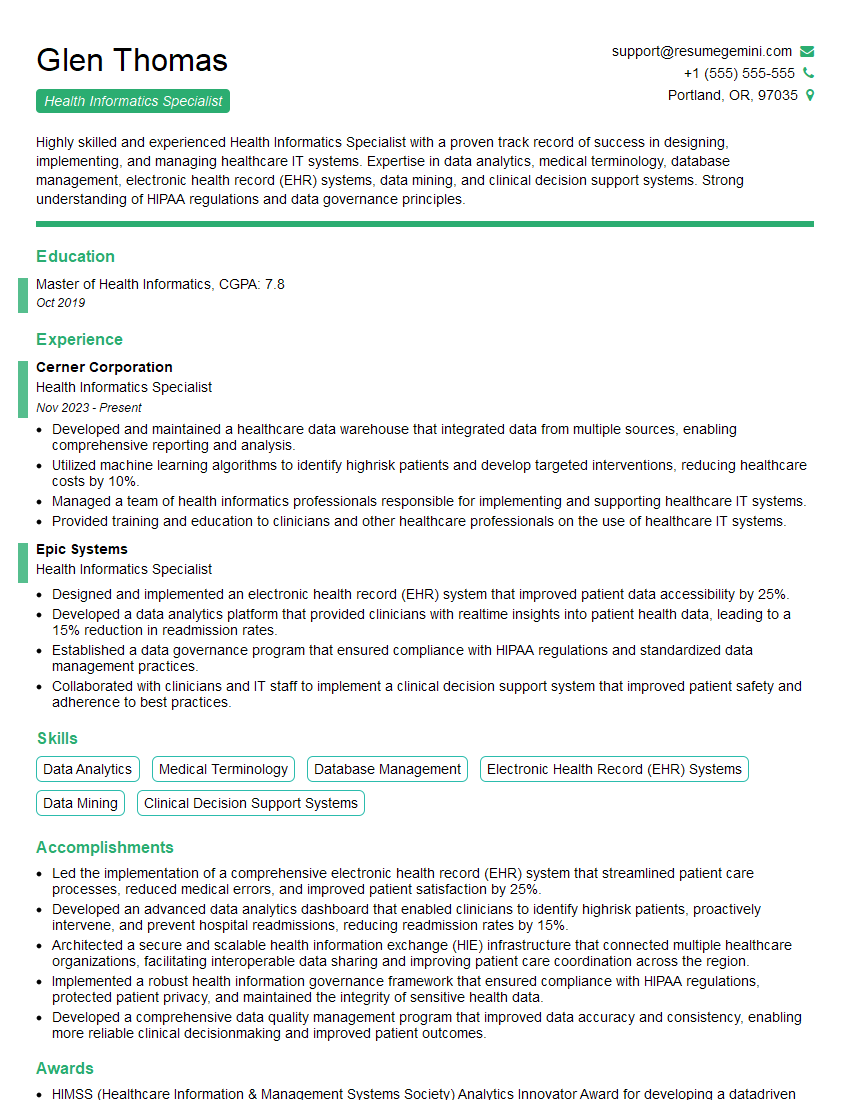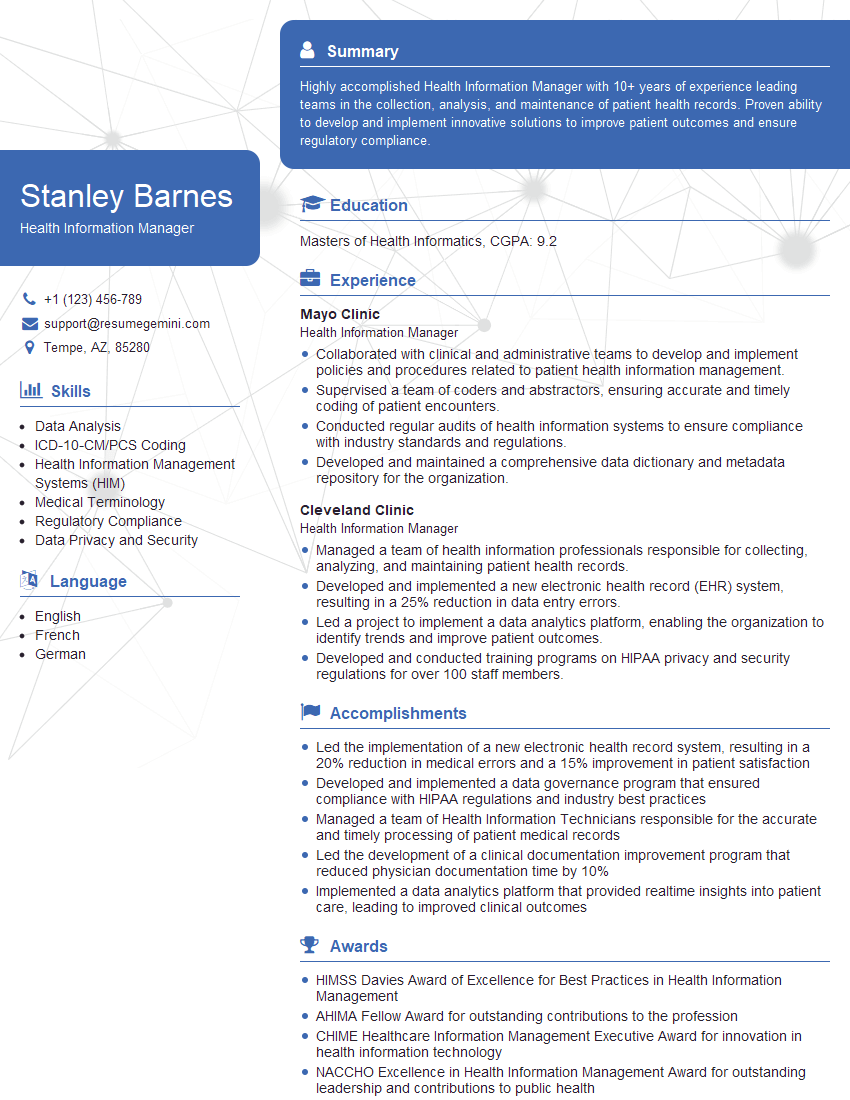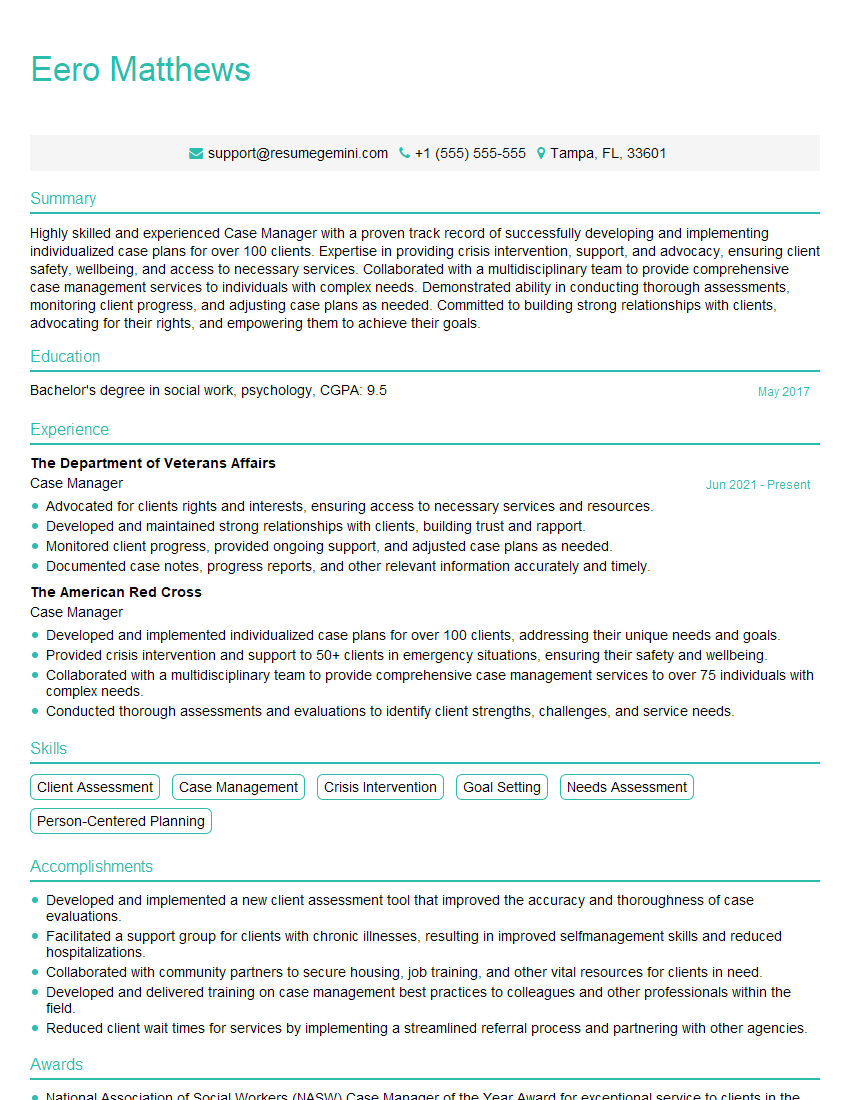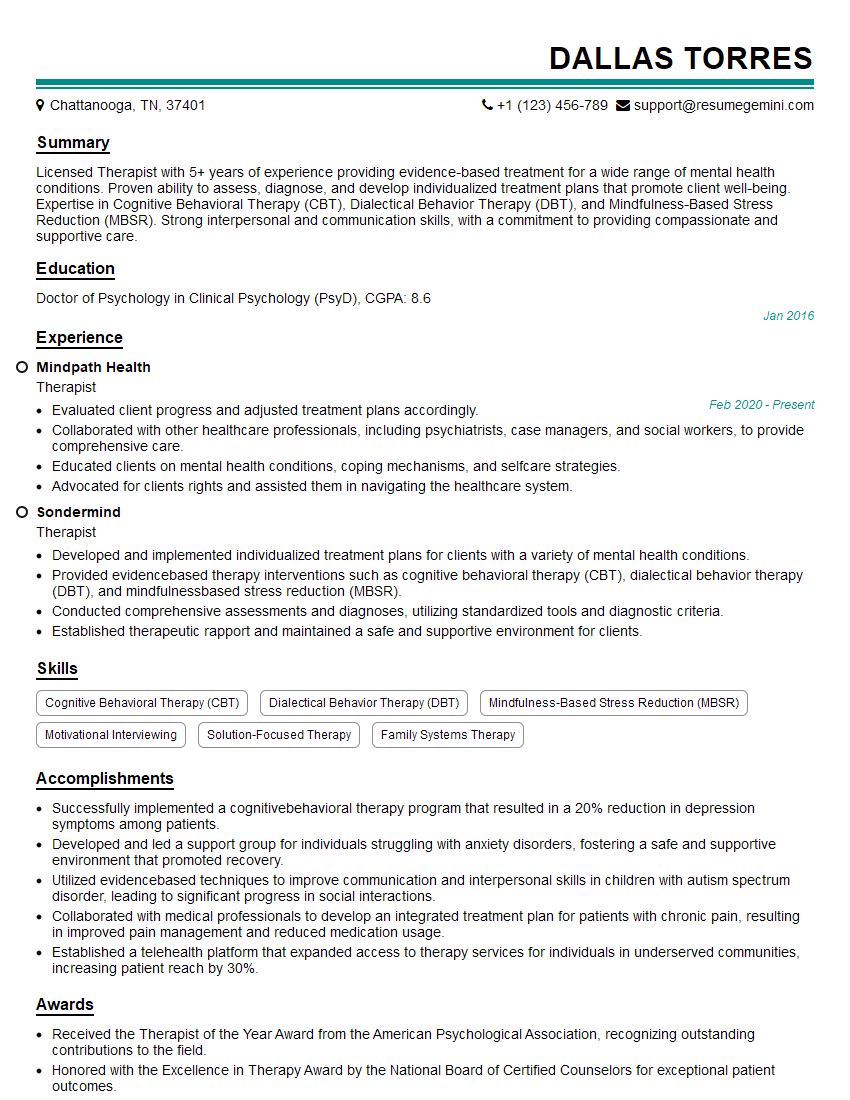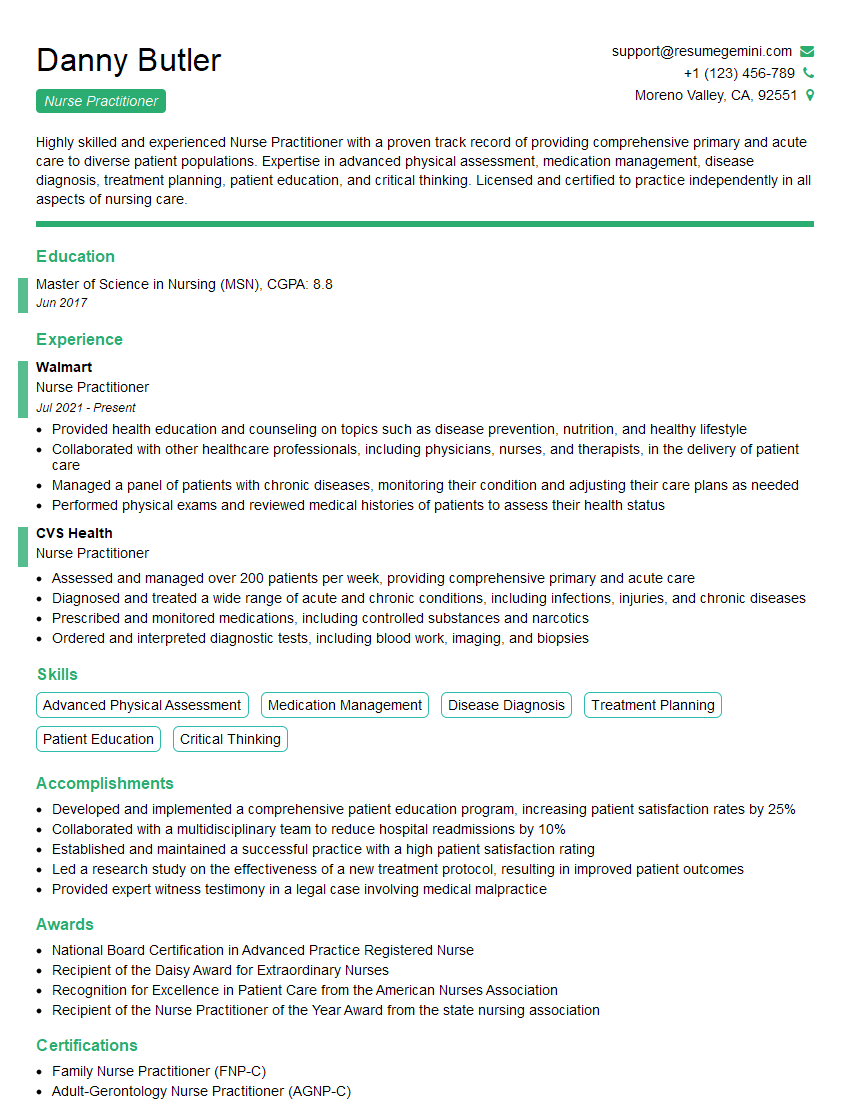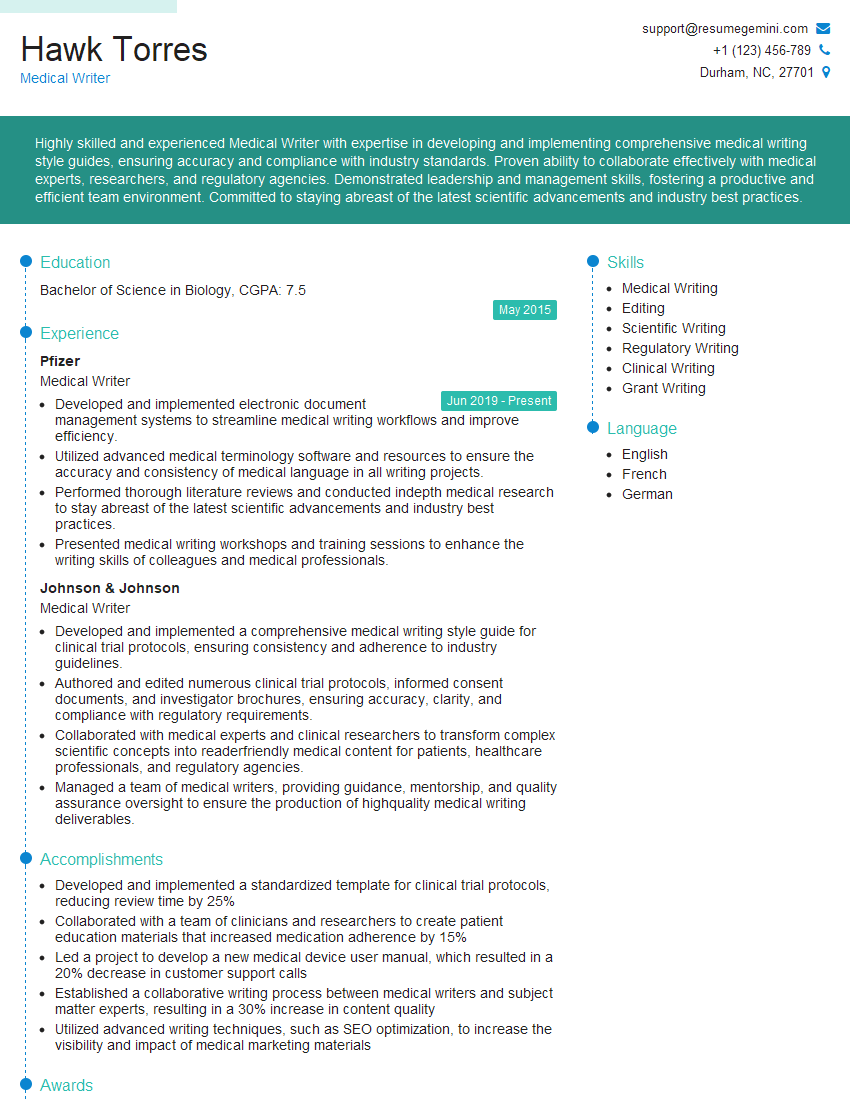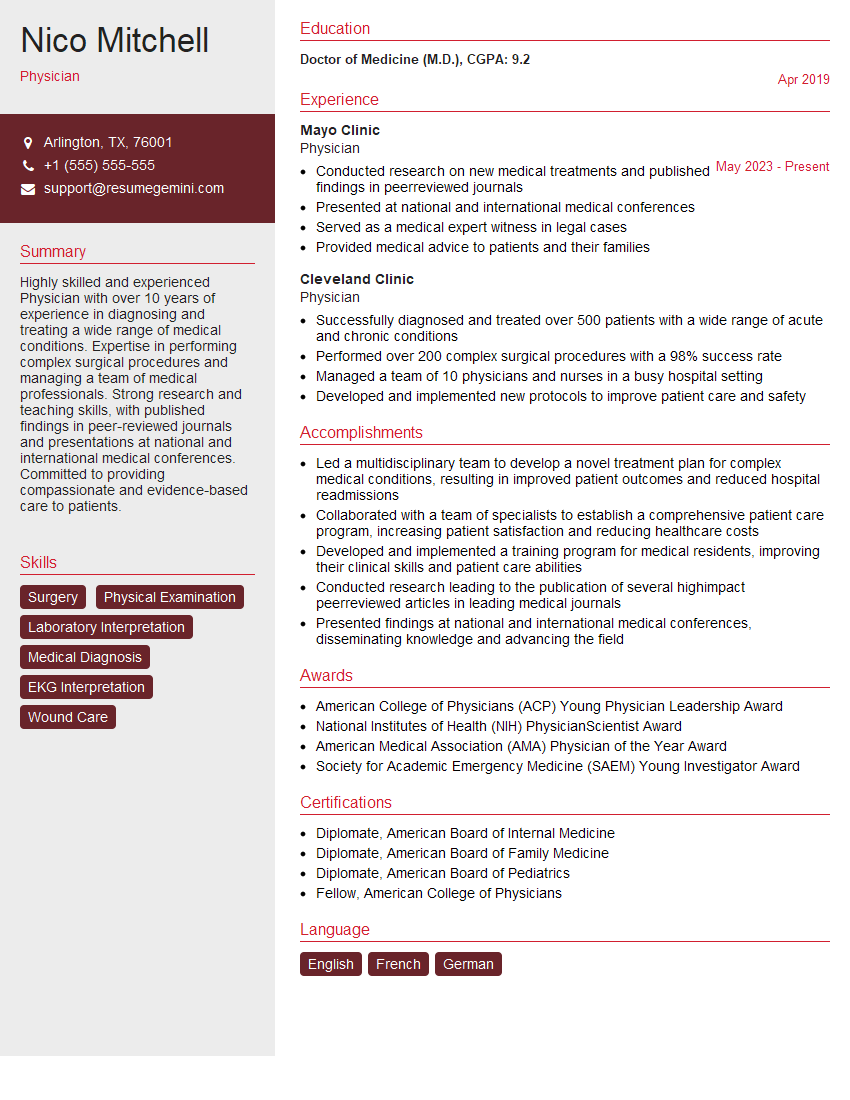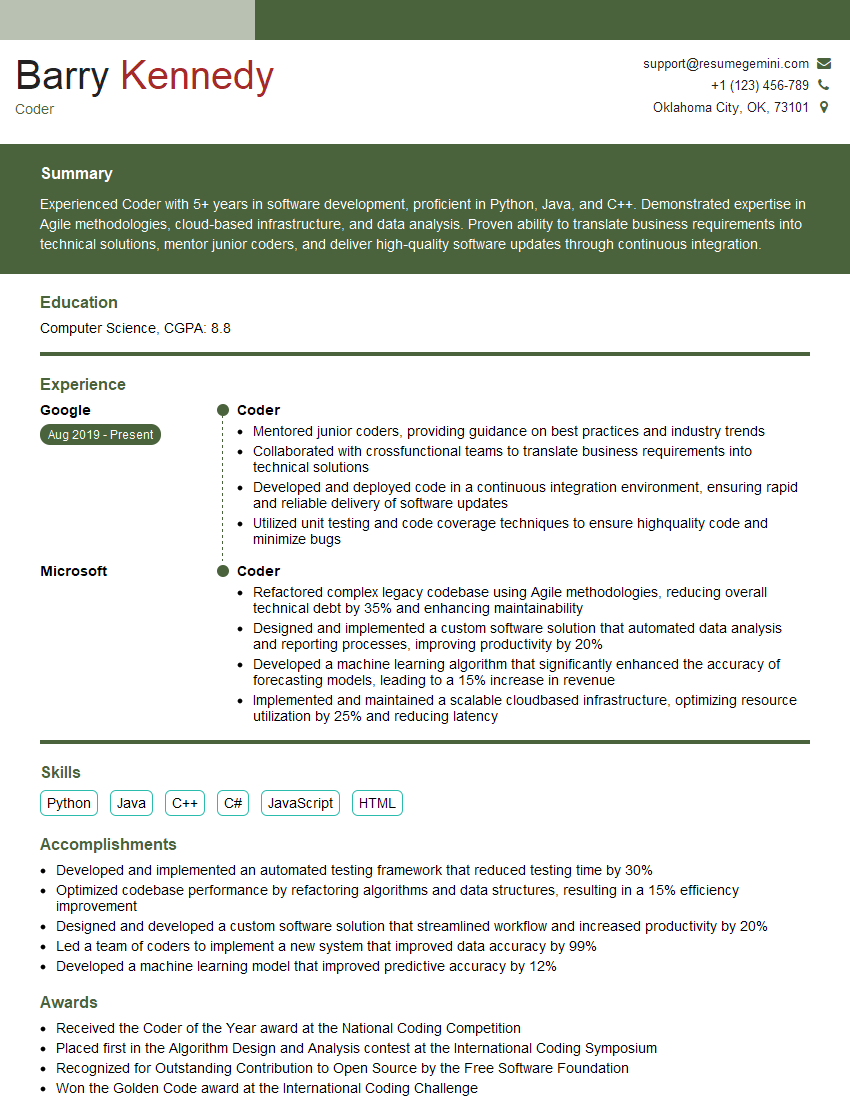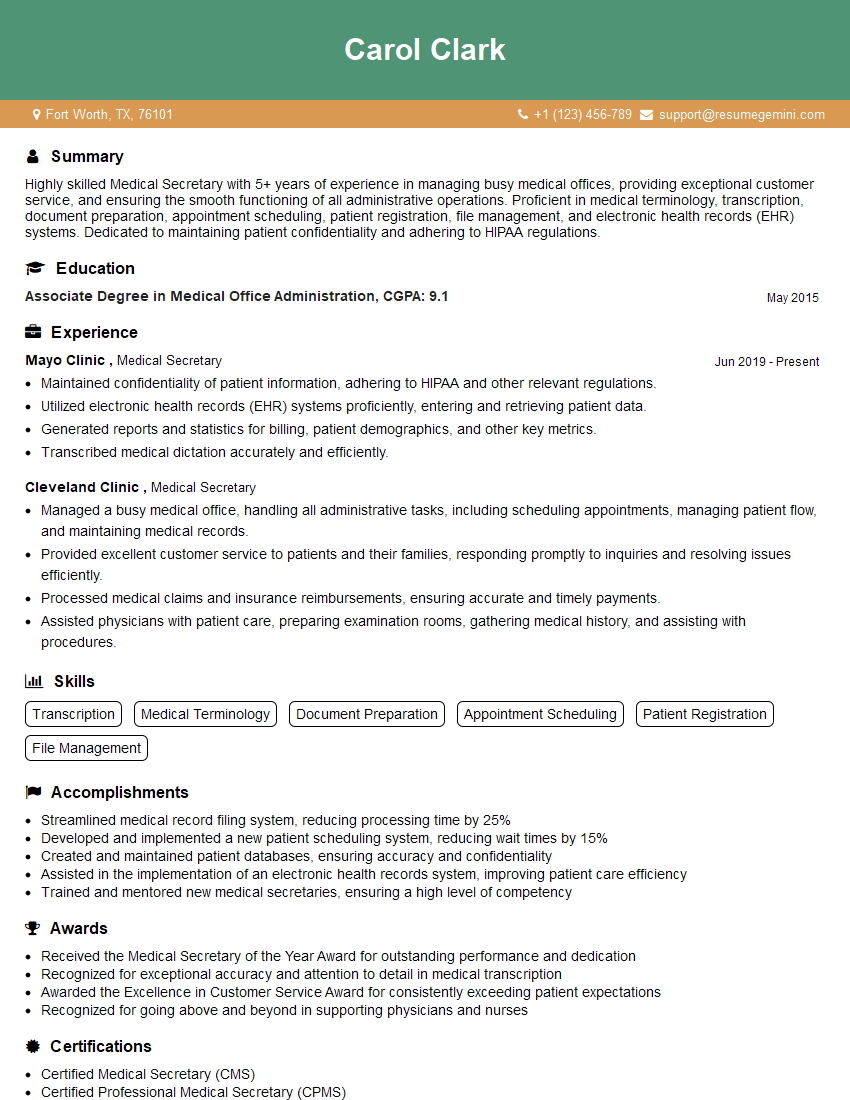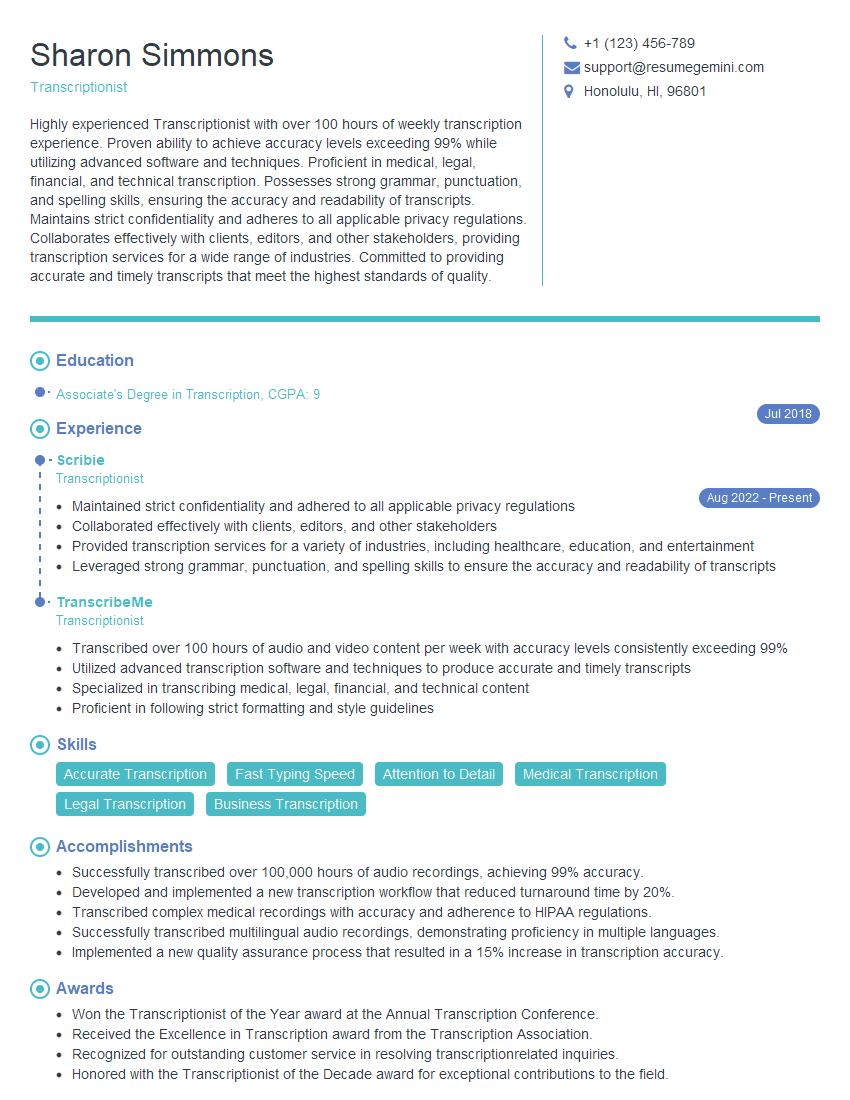Cracking a skill-specific interview, like one for Writing Progress Notes, requires understanding the nuances of the role. In this blog, we present the questions you’re most likely to encounter, along with insights into how to answer them effectively. Let’s ensure you’re ready to make a strong impression.
Questions Asked in Writing Progress Notes Interview
Q 1. What is the purpose of writing progress notes?
Progress notes are the cornerstone of patient care documentation. Their primary purpose is to provide a chronological record of a patient’s treatment, progress, and response to interventions. This record serves multiple crucial functions: it allows healthcare providers to track a patient’s condition over time, facilitating informed decision-making; it ensures continuity of care by providing essential information to other healthcare professionals involved in the patient’s treatment; it creates a legal record that protects both the patient and the provider; and finally, it contributes to research and quality improvement initiatives by providing valuable data on treatment efficacy.
Think of them as a detailed diary of the patient’s journey through treatment, accessible to anyone involved in their care.
Q 2. Explain the SOAP note format and its components.
The SOAP note format is a widely used method for structuring progress notes. It’s an acronym that stands for Subjective, Objective, Assessment, and Plan. Let’s break down each component:
- Subjective (S): This section captures information reported by the patient, such as their symptoms, feelings, and concerns. It’s presented in the patient’s own words, enclosed in quotation marks whenever possible. Example: “My pain is a 7 out of 10 today, and I haven’t slept well.”
- Objective (O): This section contains measurable and observable data gathered during the assessment. This includes vital signs (blood pressure, heart rate, temperature), physical examination findings, laboratory results, and other quantifiable information. Example: “Temperature 99.2°F, Blood pressure 130/80 mmHg, Pulse 88 bpm. Patient exhibits mild edema in right ankle.”
- Assessment (A): This is the provider’s interpretation of the subjective and objective data. It includes a diagnosis or problem list and an overall evaluation of the patient’s condition. This section integrates the subjective and objective findings to form a comprehensive understanding of the patient’s state. Example: “Possible exacerbation of chronic obstructive pulmonary disease (COPD), based on subjective complaints and objective findings.”
- Plan (P): This outlines the treatment plan for the patient, including medications, therapies, further investigations, referrals, and patient education. Example: “Continue current medication regimen. Schedule follow-up appointment in one week. Instruct patient on proper inhaler technique.”
Using SOAP notes ensures a structured, comprehensive, and easily understandable record of the patient encounter.
Q 3. Describe the importance of accurate and timely documentation in progress notes.
Accurate and timely documentation is paramount for several reasons. Inaccurate records can lead to misdiagnosis, inappropriate treatment, and adverse patient outcomes. Delays in documentation create gaps in the patient’s record, hindering continuity of care and potentially exposing both the patient and the provider to legal risks. Accurate documentation ensures that all relevant information is readily available to the healthcare team, promoting efficient and effective care.
Imagine a scenario where a patient’s allergy to penicillin isn’t documented. A subsequent prescription of a penicillin-based antibiotic could have life-threatening consequences. Timely documentation prevents such situations by providing a complete and current overview of the patient’s condition and treatment.
Q 4. How do you ensure the clarity and conciseness of your progress notes?
Clarity and conciseness are achieved through careful word choice, precise language, and a structured format like SOAP. Avoid jargon and medical abbreviations unless the audience is familiar with them. Use short, declarative sentences and avoid unnecessary details. Always focus on recording only relevant information directly related to the patient’s care and treatment.
For example, instead of writing ‘Pt. c/o severe pain,’ write ‘Patient reports severe pain (10/10) in the left shoulder.’ The second example is clearer, more precise, and provides more useful clinical information.
Q 5. What are the legal and ethical considerations when writing progress notes?
Legal and ethical considerations are central to progress note writing. All entries must be factual, objective, and reflect the actual events of the patient encounter. Subjective opinions should be clearly distinguished from objective findings. Maintaining patient confidentiality is crucial; only authorized individuals should have access to the record. False or misleading information can lead to legal repercussions, including malpractice lawsuits. Furthermore, ethical guidelines require that the documentation accurately reflects the care provided and adheres to professional standards.
Remember, progress notes can be used as evidence in legal proceedings. Therefore, accuracy and objectivity are not just good practice; they are essential for legal protection.
Q 6. How do you handle conflicting information from different sources when documenting in progress notes?
Handling conflicting information requires careful consideration and documentation. Document all sources of information, including who provided the information and the context in which it was obtained. Note any discrepancies between different reports. If possible, attempt to reconcile the conflicting information by seeking clarification or further assessment. If the conflict remains unresolved, clearly state the discrepancies in the progress note and explain how the provider resolved the issue or decided to proceed with the care plan, emphasizing the rationale behind the decision.
For instance, if a patient reports feeling well, but their blood pressure is elevated, this discrepancy should be noted, and the provider’s reasoning for their chosen course of action should be clearly explained.
Q 7. Explain your understanding of HIPAA and its relevance to progress note writing.
The Health Insurance Portability and Accountability Act (HIPAA) is a US law designed to protect the privacy and security of patient health information (PHI). Progress notes contain significant amounts of PHI, and therefore, HIPAA compliance is mandatory. This includes adhering to regulations regarding the disclosure of PHI, securing electronic health records (EHRs), and implementing appropriate safeguards to prevent unauthorized access or breaches of confidentiality. All staff involved in handling progress notes must receive adequate training on HIPAA regulations to ensure compliance. Failure to comply with HIPAA can result in severe penalties.
Think of HIPAA as a shield protecting patient privacy. Every entry in a progress note must respect this shield and adhere to the stringent rules put in place to safeguard sensitive information.
Q 8. How do you ensure patient confidentiality while writing progress notes?
Patient confidentiality is paramount in healthcare. Ensuring this while writing progress notes involves adhering strictly to HIPAA regulations and hospital policies. This means never leaving notes visible to unauthorized personnel, using strong passwords to protect electronic health records (EHRs), and always logging out of systems when finished.
Specific practices I employ include:
- Strict adherence to HIPAA: I only access records I need for my assigned duties, and I never discuss patient information outside of the appropriate channels.
- Secure data handling: I understand and follow all policies regarding password security, data encryption, and the disposal of paper records.
- Proper patient identification: Before accessing or documenting anything, I always verify patient identity using multiple identifiers.
- Data minimization: I only document information directly relevant to the patient’s care and avoid including unnecessary personal details.
Think of it like a locked safe – only authorized individuals with the correct key (access privileges) can open it and view the contents (patient information). Any breach of these protocols is treated with the utmost seriousness, and I am committed to maintaining the highest standards of patient privacy.
Q 9. Describe a time you had to correct an error in a progress note. What was the process?
I once mistakenly documented a patient’s blood pressure as 160/90 instead of 120/80. I discovered the error during a later chart review. My process for correcting this was as follows:
- Immediate identification: I noted the error immediately.
- Documentation of correction: I didn’t delete the incorrect entry. Instead, I added a new entry with the correct blood pressure reading. I clearly indicated that this was a correction to the previous entry. This shows a clear audit trail.
- Reason for correction: I briefly explained the reason for the correction (e.g., ‘Correction of previously documented blood pressure due to transcription error’).
- Initials and timestamp: I added my initials and the date and time of the correction.
- No attempt to hide or delete the original entry: The original entry remained visible, demonstrating transparency and accountability.
The key is transparency and accuracy. Deleting or altering entries to conceal errors is a serious breach of ethical standards and can have significant legal consequences. A clear audit trail is crucial in healthcare documentation.
Q 10. How do you adapt your writing style to different audiences (e.g., physicians, nurses, administrators)?
Adapting my writing style to different audiences is crucial for effective communication. I adjust my language, terminology, and level of detail based on the reader’s background and needs.
- Physicians: I use precise medical terminology, concise sentences, and focus on clinical findings and assessment. I highlight key diagnostic and treatment information.
- Nurses: My notes include more detailed descriptions of the patient’s condition, including vital signs, medications, and response to treatment. I emphasize instructions and observations pertinent to their care.
- Administrators: I provide summaries focusing on overall progress, resource utilization, and billing information. I avoid technical jargon and use plain language.
For example, when writing for a physician, I might say, ‘Patient presents with acute exacerbation of COPD, exhibiting dyspnea and increased wheezing.’ For a nurse, I might add, ‘Patient’s oxygen saturation is 88% on room air, requiring supplemental oxygen at 2L/min via nasal cannula. Administer nebulizer treatment as per protocol.’ This ensures everyone receives the information they need in a format they understand.
Q 11. What software or systems are you proficient in for electronic progress note entry?
I am proficient in several electronic health record (EHR) systems including Epic, Cerner, and Meditech. I’m also experienced with various documentation software such as Dragon NaturallySpeaking (for voice-to-text transcription). My skills extend to using these systems to effectively and efficiently create and manage progress notes, ensuring data integrity and adherence to all applicable regulations.
My expertise includes understanding and using all the features of these systems, including templates, structured data entry, and the use of standardized terminologies. I am comfortable navigating multiple screens and efficiently documenting patient encounters.
Q 12. How do you stay current with changes in documentation guidelines and regulations?
Staying current with changes in documentation guidelines and regulations is vital for maintaining compliance and providing high-quality care. I regularly engage in continuing education activities, including:
- Professional development courses: I participate in workshops and seminars focused on medical record keeping and legal compliance.
- Subscription to professional journals: I regularly read journals such as the American Medical Association’s publications to stay informed about updates in healthcare documentation.
- Professional organization memberships: Membership in relevant professional organizations provides access to updates on guidelines and best practices.
- Hospital policy reviews: I consistently review and update my knowledge on our hospital’s policies and procedures on documentation.
- Online resources: I use online resources like the Centers for Medicare & Medicaid Services (CMS) website to stay informed about regulatory changes.
Think of it like a map – the regulations are constantly being updated. Keeping abreast of these changes is essential for navigating the healthcare landscape and avoiding potential pitfalls.
Q 13. Explain your experience using standardized terminologies like SNOMED CT or ICD codes.
I have extensive experience using standardized terminologies like SNOMED CT (Systematized Nomenclature of Medicine – Clinical Terms) and ICD codes (International Classification of Diseases). These terminologies are essential for ensuring accurate and consistent coding, facilitating data analysis, and improving interoperability between different healthcare systems.
SNOMED CT provides a comprehensive, standardized vocabulary for describing clinical findings, allowing for more precise and detailed documentation. ICD codes are used for classifying diseases and other health problems, facilitating billing and statistical reporting. I’m adept at using both in my daily documentation, ensuring accurate coding and reducing the likelihood of errors.
For instance, instead of writing ‘patient has a cough,’ I’d use SNOMED CT to code the specific type of cough (e.g., ‘productive cough,’ ‘non-productive cough’), providing a much more detailed and precise description. Similarly, I’d use ICD codes to classify the underlying diagnosis contributing to the cough.
Q 14. What is your experience with different types of progress notes (e.g., narrative, problem-oriented)?
I am experienced with various types of progress notes, including narrative, problem-oriented (SOAP), and others. Each has its strengths and weaknesses, and the best approach often depends on the specific context and patient needs.
- Narrative notes: These provide a chronological account of patient encounters, offering flexibility but can sometimes lack structure and organization.
- Problem-oriented notes (SOAP): This structured approach (Subjective, Objective, Assessment, Plan) enhances clarity and organization. It’s ideal for tracking progress on specific issues.
- Other formats: I’m also familiar with other structured formats tailored to specific clinical settings or specialties.
My choice of format depends on the situation. For example, a complex case with multiple problems might benefit from a SOAP note, while a routine follow-up visit might only require a concise narrative note. My primary goal is to create clear, concise, and accurate documentation that supports effective patient care and communication among the healthcare team.
Q 15. How do you manage multiple patient charts and prioritize your progress note writing?
Managing multiple patient charts and prioritizing progress note writing requires a structured approach. Think of it like a conductor leading an orchestra – each patient requires attention, but some sections demand immediate focus. I utilize a combination of strategies:
- Prioritization Matrix: I categorize patients based on urgency. Those requiring immediate attention (e.g., post-operative patients, those with unstable conditions) are prioritized. I use a simple system – High, Medium, Low urgency – to visually organize my workload.
- Time Blocking: I allocate specific time slots for writing progress notes. This prevents rushing and ensures each note receives adequate attention. For example, I might dedicate the first hour of my morning to high-urgency notes.
- Batching Similar Tasks: I group similar tasks together. For example, I might complete all the progress notes for patients seen in the morning before moving to afternoon patients. This minimizes context switching and improves efficiency.
- Electronic Health Record (EHR) Features: I leverage the EHR’s features such as smart phrases, templates, and task lists to streamline the writing process. This allows for quicker documentation while maintaining accuracy.
For example, if I have a patient post-surgery who needs immediate pain assessment documentation and another patient with stable chronic condition, the post-surgery patient’s note will be completed first. This ensures timely and appropriate medical care.
Career Expert Tips:
- Ace those interviews! Prepare effectively by reviewing the Top 50 Most Common Interview Questions on ResumeGemini.
- Navigate your job search with confidence! Explore a wide range of Career Tips on ResumeGemini. Learn about common challenges and recommendations to overcome them.
- Craft the perfect resume! Master the Art of Resume Writing with ResumeGemini’s guide. Showcase your unique qualifications and achievements effectively.
- Don’t miss out on holiday savings! Build your dream resume with ResumeGemini’s ATS optimized templates.
Q 16. Describe your experience with auditing or reviewing progress notes for accuracy and compliance.
Auditing and reviewing progress notes is crucial for ensuring accuracy, compliance, and the continuity of patient care. It’s like proofreading an important document – a small error can have significant consequences. My experience includes:
- Chart Reviews: I regularly participate in chart reviews, focusing on elements like documentation completeness, adherence to coding guidelines (e.g., ICD-10, CPT), and proper use of medical terminology. I look for inconsistencies, missing information, and potential areas of improvement.
- Peer Review: I actively engage in peer review, providing constructive feedback to colleagues on their progress notes. This fosters a culture of continuous learning and improvement within our team.
- Compliance Audits: I have been involved in compliance audits conducted by external agencies. These audits rigorously assess our documentation practices against regulatory standards. I actively participate in addressing identified deficiencies and implementing corrective actions.
During a recent audit, I identified a pattern of missing allergy information in several charts. By highlighting this issue, we implemented a new checklist in our EHR system to ensure complete allergy documentation moving forward. This proactive approach prevented potential medication errors.
Q 17. How do you handle situations where you need to document sensitive or emotionally charged information?
Documenting sensitive or emotionally charged information requires tact and adherence to strict confidentiality guidelines. It’s like walking a tightrope – you need to be precise and careful. My approach includes:
- Factual and Objective Language: I use precise and objective language, avoiding subjective opinions or judgments. Instead of writing “patient was very upset,” I might write “patient exhibited signs of distress, including elevated heart rate and tearfulness.”
- Direct Quotes (with Caution): If a patient shares particularly sensitive information, I may use direct quotes, but only when appropriate and with careful consideration of potential ethical implications. I always note the context in which the quote was given.
- Patient Privacy and Confidentiality: I strictly adhere to HIPAA regulations and other relevant privacy laws. I never disclose protected health information to unauthorized individuals.
- Use of Standardized Terminology: Using standardized terminology for diagnoses and conditions ensures clarity and reduces the risk of misinterpretations. For example, using the official diagnosis codes avoids ambiguity.
For example, when documenting a patient disclosing a history of abuse, I would focus on factual details provided, such as dates and types of abuse experienced, while maintaining patient privacy and avoiding judgmental language. The note should accurately reflect the patient’s statement without adding opinions.
Q 18. What is your approach to dealing with incomplete or ambiguous information when writing progress notes?
Incomplete or ambiguous information is a common challenge. It’s like having a puzzle with missing pieces – you need to figure out the best way to complete the picture. My strategy includes:
- Clarification with the Patient/Caregiver: I always attempt to clarify any ambiguous information directly with the patient or their caregiver. This ensures accuracy and minimizes potential errors.
- Reviewing Existing Documentation: I thoroughly review the existing medical record for clues to fill in any gaps in information. For instance, I might refer to prior progress notes, lab results, or imaging reports.
- Documenting the Uncertainty: If I cannot clarify the information, I clearly document the uncertainty and any attempts made to obtain further information. For example, I might write, “Unable to confirm patient’s medication history due to conflicting information. Patient will be contacted for clarification.”
- Note any Limitations: It’s crucial to specify any limitations regarding the completeness of the information available. This ensures transparency and accuracy in reporting.
If, for example, a patient is vague about their pain level, instead of guessing, I would document “Patient reports pain but is unable to specify location or intensity at this time. Further assessment is needed.”
Q 19. How familiar are you with various healthcare documentation standards (e.g., Joint Commission)?
I am very familiar with various healthcare documentation standards, including those set by the Joint Commission. These standards are like a roadmap, guiding us to provide safe and high-quality patient care. My knowledge includes:
- Joint Commission Standards: I understand the Joint Commission’s requirements for complete and accurate medical record documentation, including the use of approved abbreviations and terminology.
- HIPAA Compliance: I am well-versed in HIPAA regulations and ensure all documentation practices maintain patient privacy and confidentiality.
- Meaningful Use Criteria: I am familiar with Meaningful Use criteria related to electronic health records and how documentation contributes to meeting those objectives.
- Other Regulatory Requirements: I am aware of other relevant state and federal regulations pertaining to healthcare documentation.
Understanding these standards is critical to ensuring compliance and minimizing risks to both patients and healthcare providers. For example, understanding the Joint Commission’s requirements on documentation helps in avoiding potential penalties and ensures patient safety.
Q 20. How do you ensure the completeness and comprehensiveness of your progress notes?
Ensuring completeness and comprehensiveness in progress notes is paramount. Think of it as building a strong foundation – every piece is essential. My approach involves:
- Using a Structured Approach: I use a structured approach to ensure all essential elements are included in each note. This usually involves a checklist or template to confirm all necessary sections are addressed.
- SOAP Notes: I often utilize the SOAP method (Subjective, Objective, Assessment, Plan) to organize my documentation. This format provides a consistent structure, making it easy to capture all relevant information.
- Regular Self-Review: I regularly review my own progress notes to identify areas for improvement and ensure consistency. This self-assessment is important for maintaining a high standard of documentation.
- Seeking Clarification: When unsure about certain aspects, I ask for clarification from colleagues or supervisors to prevent gaps in information.
For instance, in a SOAP note, the ‘Objective’ section would include quantifiable data such as vital signs, while the ‘Assessment’ section provides a concise summary of the patient’s condition, allowing for comprehensive understanding.
Q 21. Describe your experience with using templates or guidelines for progress note writing.
Templates and guidelines are invaluable tools in progress note writing. They’re like a recipe – they provide a framework for consistency and efficiency. My experience includes:
- Template Utilization: I regularly use pre-designed templates for common clinical encounters. These templates are customized to fit our facility’s requirements and ensure compliance with all relevant regulations.
- Customization: While templates offer structure, I always customize them to reflect the specific details of each patient encounter. No two patients are the same, and the documentation needs to accurately reflect individual circumstances.
- Continuous Improvement: Our templates are regularly reviewed and updated to reflect best practices and address any deficiencies identified through audits or feedback.
- Understanding Limitations: I’m aware that templates are just tools. They don’t replace critical thinking or the need for thorough clinical judgment. I always ensure the documentation accurately reflects the patient’s condition, even if it deviates from the standard template.
Using templates helps reduce documentation time and ensures consistent reporting. However, I always prioritize accurate and individualized patient care over adhering strictly to a template. I’d rather take extra time to ensure the documentation reflects the true clinical picture.
Q 22. How do you use progress notes to support continuity of care?
Progress notes are the cornerstone of continuity of care. They act as a detailed record of a patient’s medical journey, ensuring that every healthcare professional involved has access to the same information. This prevents duplication of tests, avoids conflicting treatments, and ultimately leads to better patient outcomes.
For example, imagine a patient admitted to the hospital for chest pain. The emergency physician’s note will document initial findings, vital signs, and preliminary diagnoses. The cardiologist’s note will then add further details from the cardiac workup, including the results of echocardiograms and cardiac enzymes. The subsequent progress notes from nurses, respiratory therapists, and other specialists will meticulously chart the patient’s progress, medication responses, and any complications. This comprehensive record allows all caregivers, including those who take over during shift changes or during referrals, to understand the patient’s situation fully, leading to seamless and coordinated care.
- Timely updates: Regularly updating progress notes is crucial for ensuring everyone is on the same page.
- Clear and concise language: Using precise medical terminology, while avoiding jargon that might confuse other professionals, is essential.
- Objective observations: Focusing on measurable data rather than subjective opinions ensures accuracy and avoids bias.
Q 23. How do you handle disagreements with clinicians regarding progress note content?
Disagreements with colleagues regarding progress note content are sometimes unavoidable. However, a professional and collaborative approach is essential. I always start by calmly and respectfully discussing the differing opinions. I would review the relevant clinical data together, perhaps referencing established guidelines or research. The goal is not to ‘win’ an argument but to reach a shared understanding that reflects the best interest of the patient.
If we can’t reach a consensus through discussion, I would involve a senior clinician or a supervisor. Their experience and impartiality can help mediate the situation and ensure the final note accurately reflects the patient’s condition. It’s crucial to document the discussion and the final agreed-upon note, including any points of disagreement and the rationale for the final decision.
In extreme cases, if there’s a serious concern about a colleague’s clinical judgment, reporting mechanisms within the institution would be followed, always prioritizing patient safety and upholding ethical standards.
Q 24. Describe your experience with using data from progress notes for quality improvement initiatives.
Progress notes are a rich source of data for quality improvement (QI) initiatives. In my previous role, we used data extracted from progress notes to analyze readmission rates for heart failure patients. By analyzing trends in symptoms documented in the notes (e.g., shortness of breath, edema), we identified patterns that predicted increased risk of readmission. This allowed us to develop a targeted intervention program focusing on patient education and improved discharge planning, leading to a significant reduction in readmissions.
We also used natural language processing (NLP) techniques to analyze the content of progress notes and identify common themes related to medication errors. This allowed us to develop new protocols for medication administration and improve the system of double-checking prescriptions, significantly reducing the rate of medication-related adverse events.
The ability to analyze large datasets from progress notes is invaluable for identifying areas for improvement in patient care, enhancing processes, and ultimately improving the overall quality of healthcare delivery.
Q 25. How do you identify and avoid potential legal risks in progress note writing?
Legal risks in progress note writing are a serious concern, and meticulous documentation is key to mitigating them. The most critical aspect is ensuring the notes are accurate, complete, and objective. Avoid subjective opinions or interpretations; stick to factual observations and measurements.
- Use precise language: Avoid vague terms and ensure clarity in describing diagnoses, treatments, and patient responses.
- Timely documentation: Enter notes promptly after an interaction with the patient or during assessment to ensure accuracy and avoid memory lapses.
- Never alter a note: If a mistake is made, a correction should be made with a note indicating the change, the date, and the reason.
- Maintain confidentiality: Ensure all patient information is protected in accordance with HIPAA (or relevant privacy laws).
- Avoid accusatory language: Focus on factual reporting rather than placing blame or making judgments.
By following these best practices, the risk of legal challenges related to inaccurate or incomplete documentation can be substantially reduced.
Q 26. What strategies do you use to improve efficiency in progress note writing?
Efficiency in progress note writing is crucial for managing a heavy workload. I use several strategies to improve my efficiency:
- Templates and pre-written phrases: Using templates for common procedures or patient encounters saves significant time. I also create a library of pre-written phrases for commonly used descriptions.
- Voice-to-text software: Dictating notes is significantly faster than typing, allowing me to focus on the patient interaction rather than writing.
- Use of abbreviations and acronyms: Utilizing approved abbreviations and acronyms allows efficient writing, provided they are widely understood within the healthcare team.
- Prioritization of key information: I focus on documenting the most essential aspects of the patient encounter, avoiding unnecessary details.
- Regular review and refinement: Periodically reviewing my note-writing process enables identification of areas for improvement and adaptation of new strategies.
Q 27. Explain how your writing skills contribute to effective communication and collaboration within the healthcare team.
Effective communication and collaboration are paramount in healthcare. My writing skills are critical in this process. Clear, concise, and well-organized progress notes ensure that all members of the healthcare team have access to the same information, facilitating seamless care coordination.
For example, my detailed description of a patient’s response to a medication allows the pharmacist to assess potential drug interactions. Precise documentation of a patient’s symptoms enables the physician to promptly diagnose and treat a condition. Similarly, a clearly communicated plan of care prevents confusion and promotes consistency in the approach to treatment. In essence, my writing skills translate medical information into a common language that everyone can understand, fostering better teamwork and leading to enhanced patient safety and care.
Key Topics to Learn for Writing Progress Notes Interview
- Understanding the Purpose of Progress Notes: Learn the different types of progress notes (SOAP, DAP, etc.) and their specific applications in various healthcare settings. Understand the legal and ethical considerations surrounding accurate and thorough documentation.
- Structuring Effective Progress Notes: Master the art of concise and clear writing, focusing on objective observations and avoiding subjective opinions. Practice using appropriate medical terminology and abbreviations while maintaining readability.
- Data Collection and Integration: Explore methods for efficiently gathering relevant patient information from various sources (e.g., patient interviews, medical charts, diagnostic tests). Understand how to seamlessly integrate this information into a coherent progress note.
- Problem-Solving and Critical Thinking: Practice analyzing patient data to identify key issues and treatment progress. Develop the ability to articulate your clinical reasoning and decision-making processes within the progress note.
- Maintaining Confidentiality and HIPAA Compliance: Understand the legal and ethical responsibilities related to patient privacy and data security. Practice writing progress notes that adhere to HIPAA regulations.
- Time Management and Efficiency: Develop strategies for writing comprehensive and accurate progress notes efficiently, balancing speed and quality within the demands of a busy work environment.
- Electronic Health Record (EHR) Systems: Familiarize yourself with different EHR systems and their specific requirements for progress note documentation. Practice navigating these systems efficiently and accurately.
Next Steps
Mastering the art of writing effective progress notes is crucial for career advancement in healthcare. Clear, concise, and accurate documentation is essential for patient care, legal compliance, and effective communication among healthcare professionals. To stand out to potential employers, create an ATS-friendly resume that highlights your skills and experience. We highly recommend using ResumeGemini to build a professional and impactful resume that will get noticed. Examples of resumes tailored to showcasing Writing Progress Notes expertise are available to help you get started.
Explore more articles
Users Rating of Our Blogs
Share Your Experience
We value your feedback! Please rate our content and share your thoughts (optional).
What Readers Say About Our Blog
Hi, I have something for you and recorded a quick Loom video to show the kind of value I can bring to you.
Even if we don’t work together, I’m confident you’ll take away something valuable and learn a few new ideas.
Here’s the link: https://bit.ly/loom-video-daniel
Would love your thoughts after watching!
– Daniel
This was kind of a unique content I found around the specialized skills. Very helpful questions and good detailed answers.
Very Helpful blog, thank you Interviewgemini team.
